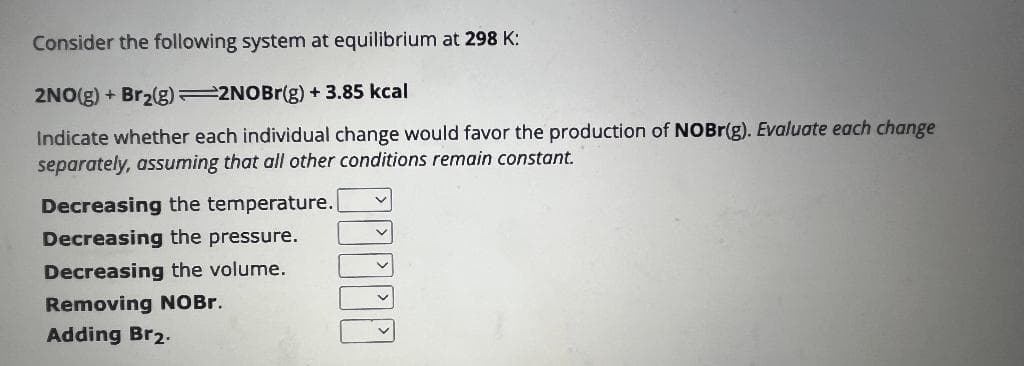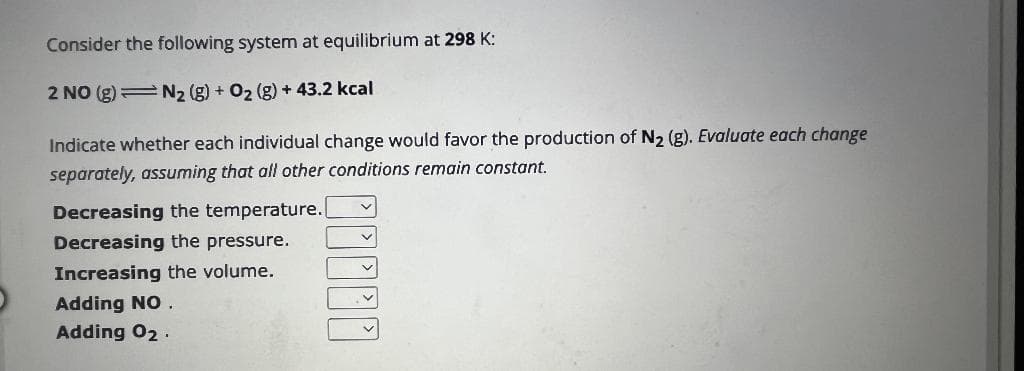Consider the following system at equilibrium at 298 K: 2NO(g) + Br₂(g) 2NOBr(g) + 3.85 kcal Indicate whether each individual change would favor the production of NOBr(g). Evaluate each change separately, assuming that all other conditions remain constant. Decreasing the temperature. Decreasing the pressure. Decreasing the volume. Removing NOBr. Adding Br2. _____
Consider the following system at equilibrium at 298 K: 2NO(g) + Br₂(g) 2NOBr(g) + 3.85 kcal Indicate whether each individual change would favor the production of NOBr(g). Evaluate each change separately, assuming that all other conditions remain constant. Decreasing the temperature. Decreasing the pressure. Decreasing the volume. Removing NOBr. Adding Br2. _____
Chemistry: An Atoms First Approach
2nd Edition
ISBN:9781305079243
Author:Steven S. Zumdahl, Susan A. Zumdahl
Publisher:Steven S. Zumdahl, Susan A. Zumdahl
Chapter16: Spontaneity, Entropy, And Free Energy
Section: Chapter Questions
Problem 83AE: Consider the following system at equilibrium at 25C: PCl3(g)+Cl(g)PCl5(g)G=92.50KJ What will happen...
Related questions
Question
Give typed explanation of both otherwise leave it
Not a single word hand written otherwise leave it

Transcribed Image Text:Consider the following system at equilibrium at 298 K:
2NO(g) + Br₂(g) 2NOBr(g) + 3.85 kcal
Indicate whether each individual change would favor the production of NOBr(g). Evaluate each change
separately, assuming that all other conditions remain constant.
Decreasing the temperature.
Decreasing the pressure.
Decreasing the volume.
Removing NOBr.
Adding Br2.
_____

Transcribed Image Text:Consider the following system at equilibrium at 298 K:
2 NO (g) = N₂ (g) + O₂ (g) + 43.2 kcal
Indicate whether each individual change would favor the production of N₂ (g). Evaluate each change
separately, assuming that all other conditions remain constant.
Decreasing the temperature.
Decreasing the pressure.
Increasing the volume.
Adding NO.
Adding 02.
Expert Solution
This question has been solved!
Explore an expertly crafted, step-by-step solution for a thorough understanding of key concepts.
This is a popular solution!
Trending now
This is a popular solution!
Step by step
Solved in 3 steps

Knowledge Booster
Learn more about
Need a deep-dive on the concept behind this application? Look no further. Learn more about this topic, chemistry and related others by exploring similar questions and additional content below.Recommended textbooks for you

Chemistry: An Atoms First Approach
Chemistry
ISBN:
9781305079243
Author:
Steven S. Zumdahl, Susan A. Zumdahl
Publisher:
Cengage Learning

Chemistry by OpenStax (2015-05-04)
Chemistry
ISBN:
9781938168390
Author:
Klaus Theopold, Richard H Langley, Paul Flowers, William R. Robinson, Mark Blaser
Publisher:
OpenStax

Chemistry: The Molecular Science
Chemistry
ISBN:
9781285199047
Author:
John W. Moore, Conrad L. Stanitski
Publisher:
Cengage Learning

Chemistry: An Atoms First Approach
Chemistry
ISBN:
9781305079243
Author:
Steven S. Zumdahl, Susan A. Zumdahl
Publisher:
Cengage Learning

Chemistry by OpenStax (2015-05-04)
Chemistry
ISBN:
9781938168390
Author:
Klaus Theopold, Richard H Langley, Paul Flowers, William R. Robinson, Mark Blaser
Publisher:
OpenStax

Chemistry: The Molecular Science
Chemistry
ISBN:
9781285199047
Author:
John W. Moore, Conrad L. Stanitski
Publisher:
Cengage Learning

Chemistry & Chemical Reactivity
Chemistry
ISBN:
9781133949640
Author:
John C. Kotz, Paul M. Treichel, John Townsend, David Treichel
Publisher:
Cengage Learning

Chemistry & Chemical Reactivity
Chemistry
ISBN:
9781337399074
Author:
John C. Kotz, Paul M. Treichel, John Townsend, David Treichel
Publisher:
Cengage Learning

Chemistry: Principles and Practice
Chemistry
ISBN:
9780534420123
Author:
Daniel L. Reger, Scott R. Goode, David W. Ball, Edward Mercer
Publisher:
Cengage Learning